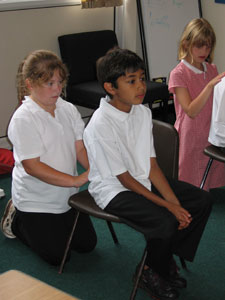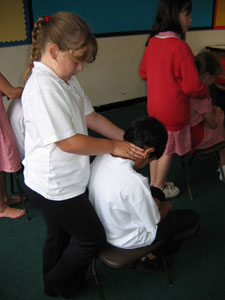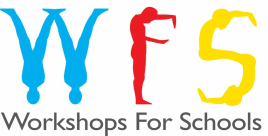
Massage In Schools Workshops The Massage in Schools Programme (MISP) is based on a Swedish method. Now 1,000 British primary schools put aside about 10 minutes a day for their fully-clothed pupils to calmly massage or trace shapes on their partner's head, shoulders, neck and back. The massage strokes, which are demonstrated by the teacher on another adult can be anything from the "bear-walk" to the "cat grip" or "bunny-hop", but the result is the same: pupils are left relaxed and ready to learn.
Children like to have their self-esteem boosted. Massage is another way of doing this because pupils must give permission; it helps them trust and respect each other and is a powerful antidote to bullying. It also re-introduces the role of positive physical touch, "Physical contact is a rare thing in today's schools, even in PE, but it has so many benefits."
Children like to have their self-esteem boosted. Massage is another way of doing this because pupils must give permission; it helps them trust and respect each other and is a powerful antidote to bullying. It also re-introduces the role of positive physical touch, "Physical contact is a rare thing in today's schools, even in PE, but it has so many benefits."

MISP works particularly well in primary schools, although it can also break down barriers and tensions between Year 7s as well. It increases children's ability to socialize and make friends, and, because it reduces stress levels, it helps the brain become more receptive to information.
How it works
To understand how peer massage works, you need look no further than the neurological system. Massage increases levels of the feel-good hormones dopamine and serotonin in the brain. Oxytocin, another hormone that relieves stress and is thought to help humans bond with one another, is also released. The hormonal changes result in happier, calmer and more focused pupils, teachers report.
Benefits
Clinical trials documented by the Touch Research Institute, based at the University of Miami, show that massage can:
How it works
To understand how peer massage works, you need look no further than the neurological system. Massage increases levels of the feel-good hormones dopamine and serotonin in the brain. Oxytocin, another hormone that relieves stress and is thought to help humans bond with one another, is also released. The hormonal changes result in happier, calmer and more focused pupils, teachers report.
Benefits
Clinical trials documented by the Touch Research Institute, based at the University of Miami, show that massage can:
- Reduce aggression
- Improve behavioural problems
- Help counter Attention Deficit Hyperactivity Disorder (ADHD)
- Relieve anxiety
- Reduce insomnia
